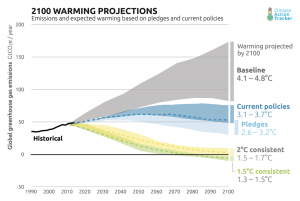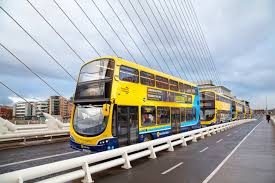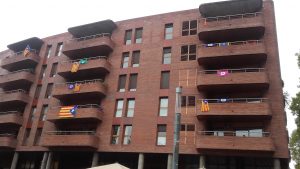I attended a Stop Climate Chaos/350.org meeting recently. A topic caught my attention ‘Are we all climate change deniers?’ Closer to believing Trump’s beautiful MAGA world for winners behind walls while ignoring Brussel’s eco-socialist Europe attempt to save the world. Ignorance & over-reliance on unknown & unbuilt technologies, hope for a few vs despair for the vulnerable.
 To quote from 350.org: “Even if we do manage to keep 80% of fossil fuels in the ground, a world that’s 2°C warmer is going to be a much different, scarier place. We’re only at +1°C now, and we’re already seeing more storms, flooding, heatwaves, drought, and island nations at risk of going underwater. +2°C is going to mean a lot of human suffering, and tremendous damage to the planet.”
To quote from 350.org: “Even if we do manage to keep 80% of fossil fuels in the ground, a world that’s 2°C warmer is going to be a much different, scarier place. We’re only at +1°C now, and we’re already seeing more storms, flooding, heatwaves, drought, and island nations at risk of going underwater. +2°C is going to mean a lot of human suffering, and tremendous damage to the planet.”
To quote from the EPA website: “Fossil fuels accounted for 77 per cent of all energy used in Ireland in 2015 with oil continuing to be the dominant energy source in 2015, with a share of 57 per cent.” The European Commission is looking at ways to make the European economy more climate-friendly and less energy-consuming, suggesting that: by 2050, the EU members should cut greenhouse gas emissions to 80% below 1990 levels. Milestones to achieve this are 40% emissions cuts by 2030 and 60% by 2040. All sectors need to contribute.
The Irish government sustainable targets are way out the window. Instead of a 20% reduction from 1990 figures by 2020, Ireland is 20% over and climbing, which makes a 40% reduction by 2030 almost impossible. Cutting 80% of current demand in 32 years!! It is essential to accept that all future development will be limited by climate change targets.EU growth policy will switch to circular, sustainable systems. It is unclear how Brexit and EU-tariffs will impact on the ‘just-in-time’ supply network for Irish supermarkets from British suppliers and manufacturers and visa-versa This might be the next economic crash.
For example, do we need another runway at Dublin airport by 2030 if flying becomes unacceptable or population is decentralised? Spending a fortune on piping water from the Shannon to Dublin rather than minimising leaks and increasing efficiency in a smaller city? Dredging Dublin Bay and adapting the port to accommodate massive cruise-liners so 4,000 people can spend 8 hours in Dublin city? Building highways for commuters to Dublin when government policy is to develop the secondary cities, reduce fossil fuel sales, increase rail travel and control electricity demand? Is this the last gasp of intensive fossil fuel burning, greenhouse gas emitting capitalism to take profits from the public purse? Like a dying wasp sucks juice from a withering peach before a 100-year winter?
Future housing across Ireland must be in livable neighborhoods where people can ‘work, rest and play’ with safe cycling, walking, a few electric/hydrogen cars, local bus routes and Dial a Taxi for the infirm, intensive food growing on city edges, local processing and home-delivery by bicycle or electric van. Governments will have to balance decarbonisation, degrowth, decentralisation and possibly lower tax revenue with maintaining the quality of life. Finding ways to do more with less, for all, less cars & planes and more trains.
 The Dublin Bus area plan building a network of “next generation” bus corridors on the busiest bus routes using ‘hubs’ and ‘crossing routes’ to make bus journeys faster, predictable and reliable; completely redesigning the network of bus routes to provide a more efficient network, connecting more places and carrying more passengers. In theory it is a good idea taking some of the cross-city bus fleet away from O’Connell Street, adding an orbital route (Line O) around the North and South Circular Roads, ‘Park & Ride’ and feeding passengers to/from existing Luas stations My questions are: will all be ready before the ‘next generation’ starts (road-widening, electronic signing, union recognition, shelters, etc), does it meet future needs for a car-free city, or will it be a waste of money with too many empty buses?
The Dublin Bus area plan building a network of “next generation” bus corridors on the busiest bus routes using ‘hubs’ and ‘crossing routes’ to make bus journeys faster, predictable and reliable; completely redesigning the network of bus routes to provide a more efficient network, connecting more places and carrying more passengers. In theory it is a good idea taking some of the cross-city bus fleet away from O’Connell Street, adding an orbital route (Line O) around the North and South Circular Roads, ‘Park & Ride’ and feeding passengers to/from existing Luas stations My questions are: will all be ready before the ‘next generation’ starts (road-widening, electronic signing, union recognition, shelters, etc), does it meet future needs for a car-free city, or will it be a waste of money with too many empty buses?
Harold’s Cross. Between the A and F spines, an additional radial is needed solely to serve the segment of Harold’s Cross Road between Harold’s Cross and Terenure. Route 16 is retained for this purpose, operating every 20 minutes all day and every 10 minutes at peak times. Beyond Terenure this route resembles the current 15b route to Stocking Ave.
Kimmage, Perrystown, Greenhills. The F spine, branching at Kimmage, provides direct city service to most of these areas, supplemented by one branch of the D spine. Note that the F1 and F2 provide 15 minutes service when together, 30 when apart (10 minutes and 20 minutes respectively at peak times). This area currently has a range of frequencies in the 15-30 minute range. We standardise these to 15 or 30, with 15 minute
service focused on the places of highest demand.
Kildare Road, Clogher Road, Donore Ave. This segment of today’s Route 150 has relatively low demand, and parts of its service area can also walk to the D spine or the new orbital Line O. A half-hourly radial, Route 20, is proposed. The route continues to Tallaght.
Crumlin Road, Cork St. The D spine replaces the three main overlapping routes (27, 77a, 151) on this segment, to deliver a consistent 5 minute frequency out to Crumlin Hospital. From there, the main branches are D2 toward Tallaght (like existing 27) and D3 toward Clondalkin, both every 15 minutes. A small branch D4, every 30 minutes, assists in covering parts of Perrystown.
Kilmainham, Rialto, Inchicore, Islandbridge. This is a very complex area where the street pattern and natural barriers defeat all reasonable routing schemes. We sought to reduce the tangle of current routes to create simple frequent patterns, even if people had to walk slightly further to them. The G Spine, every 7.5 minutes, follows Emmet Road through this area, like existing Route 40. The addition of the orbital Line O and Route S2 provide frequent service to Rialto and the area west of St. James’ Hospital, replacing the need for today’s Route 123. Instead, a new Route 22 would serve the area west of Suir, but then continuing north via Islandbridge to Heuston and the northern edge of the city centre.
Three short segments in this area currently receive bus service along Mourne Road, Keeper Road, and a portion of South Circular Road, but all are within easy walking distance of Luas or other frequent routes in the proposed network.
 Housing: We are in favour of the cost-rental model for immediate housing in the Inchicore and across Ireland, where people can work, rest & play, close to family and friends. Large, friendly, low-level apartments with amenities. Cost of buying means young working families from the area need years of saving to buy city homes, so instead buy in Laois and commute for hours each day which negates every ‘better life policy’. The existing Red Luas line (Tallaght to The Point) allows easy access to good jobs in James’s, manufacturing, hospitality and retail. The shops, museums, cafes, the schools and sports clubs need young people living in the neighbourhood to create a vibrant society.
Housing: We are in favour of the cost-rental model for immediate housing in the Inchicore and across Ireland, where people can work, rest & play, close to family and friends. Large, friendly, low-level apartments with amenities. Cost of buying means young working families from the area need years of saving to buy city homes, so instead buy in Laois and commute for hours each day which negates every ‘better life policy’. The existing Red Luas line (Tallaght to The Point) allows easy access to good jobs in James’s, manufacturing, hospitality and retail. The shops, museums, cafes, the schools and sports clubs need young people living in the neighbourhood to create a vibrant society.
Finally, we ask you to support the Uplift campaign Stop putting down concrete and gravel – start planting NATIVE species!!
Congratulations and welcome to Councillor Patrick Costello who will contest the Kimmage-Rathmines Ward in the forthcoming local elections.

